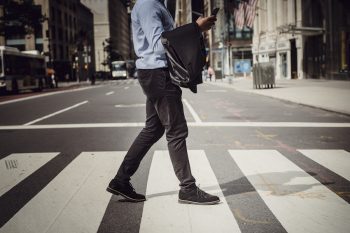Do Pedestrians Always Have the Right Of Way?

There is a popular belief that pedestrians always have the right of way in an encounter with a moving vehicle. It is a good approach to defensive driving and one that drivers should take seriously. Unfortunately, while drivers do have a legal obligation to avoid accidents involving pedestrians, some accidents are unavoidable, and in certain circumstances, a pedestrian can be legally at fault when an accident occurs.
According to Ohio law, drivers must always exercise a reasonable duty of care to avoid harming pedestrians and others who share the road. A reasonable duty of care is the expectation that a driver will take reasonable precaution to avoid harming pedestrians as much as possible, especially in commonly hazardous situations like driving through residential streets, poorly lit roads or high foot traffic areas. A driver’s duty of care includes following traffic laws including posted speed limits, watching for pedestrians, slowing down or stopping when a potential hazard becomes apparent, and yielding at all crosswalks and other pedestrian safety zones. It goes without saying that a driver must avoid distractions on the road including the use of a cell phone.
When a driver fails to exercise a reasonable duty of care and a pedestrian is harmed, that driver can be liable for injuries and damages that result from the accident. A good example of this is when a driver is traveling through a residential neighborhood. They may follow the posted speed limit but fail to slow down when they spot a child chasing a ball into the street. Exercising a reasonable duty of care would include slowing down when such a hazard becomes apparent. If the driver fails to slow down and causes injury to the child despite maintaining the legally posted speed, the driver can be held liable for those injuries.
Pedestrians are legally responsible for making sure they exercise reasonable caution as well. This means that anyone on foot must use designated pedestrian safety zones such as crosswalks, sidewalks, and walkway overpasses wherever available and may not walk on roads with restricted pedestrian activity (such as freeways.) It is important to note that when a sidewalk is available it is not legal for a pedestrian to walk in the roadway (ORC 4511.50.) When a pedestrian fails to follow traffic laws or utilize safety zones and an incident occurs, the pedestrian may cede the right of way and be liable for injuries sustained in a resulting accident. Incidents like these arise when the driver is found to have exercised a reasonable duty of care, but due to the actions of the pedestrian, could not avoid a collision.
The best strategy to avoid a pedestrian accident is for both parties to exercise reasonable care at all times when sharing the road. Drivers who speed cause around 26% of all traffic fatalities in the United States. Slowing down can greatly reduce the risk of being involved in a deadly pedestrian accident. Vehicle drivers must also maintain a heightened awareness of their surroundings. This means keeping an unobstructed view of the road and surrounding landscape. Use rearview and sideview mirrors and safety features like backup cameras and blind spot sensors to your advantage. Additionally, vehicles should make sure to remain highly visible at all times. Be sure to turn on headlights when lighting is not optimal to ensure others can easily see where you are on the road. Use turn signals, hazard lights and hand signals as required.
Pedestrians must do their part as well by making sure to enter the roadway in designated safety zones such as crosswalks whenever they are available. When a crosswalk or traffic signal is not present, a pedestrian must yield to moving vehicles and ensure that the path is safe before proceeding. Individuals on foot should also take care to remain highly visible to others on the road. Wear bright or reflective colors, carry a flashlight after dark, and stay as far to the right of the roadway and crosswalks as possible.
If you believe you were injured in a pedestrian accident and would like to find out if you have a case, contact Lowe Scott Fisher for a free legal consultation. Our attorneys may be able to help you get compensation for your injuries.
Back To Blog